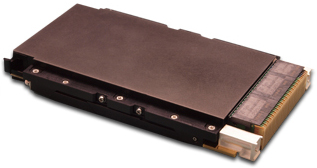Conduction-cooled tactical SBC supports Core 2 Duo
Feb 24, 2010 — by Eric Brown — from the LinuxDevices Archive — 3 viewsGeneral Dynamics Canada announced a ruggedized, conduction-cooled, single-board computer (SBC) designed for combat vehicles. Complying with VPX-REDI, the PX3030 is equipped with an Intel Core 2 Duo, 8GB of DDR3 RAM and 16GB of flash, plus two gigabit Ethernet ports, six USB 2.0 ports, and four serial ports, says the company.
The PX3030 is designed to process network communications, graphics, imagery, and video feeds needed for modern brigade combat teams, says General Dynamics Canada. Applications are said to include use in tactical wheeled vehicles including tanks, expeditionary fighting vehicles, and armament platforms. The board can also be used in airborne command and control for combat helicopters, aircraft, and unmanned aerial vehicles, says the company.

PX3030
Techniques supported by VPX-REDI include liquid cooling, enhanced forced-air cooling using baffles and plenums, and the technique used by the PX3030: advanced conduction cooling via larger and more efficient thermal interfaces. VPX REDI also calls for the use of ESD covers on both sides, as seen in the PX3030 image above, said to streamline maintenance.

PX3030 block diagram
(Click to enlarge)
Offering up to 8GB DDR3 RAM, the board is further equipped with up to 16GB of onboard SATA NAND flash. Additional storage can be connected via dual eSATA ports and six USB 2.0 ports, says the company. The PX3030 is also said to provide several PCI Express (PCIe) ports for expansion, as well as an XMC site.
Touted audio/video interfaces include RGB out, dual DVI ports, and HD audio I/O. Other I/O includes dual gigabit Ethernet ports, the aforementioned USB ports, four serial ports, and 16 GPIO interfaces, says the company.
The 3U board is said to be "about the size of a paperback novel," and weighs 1.1 pounds. Compliant with VITA 47 ruggedization standards for shock and vibration, the PX3030 can operate in temperatures ranging from -40 to 185 deg. F, says General Dynamics Canada.
Specifications listed for the PX3030 include:
- Processor — Intel Core 2 Duo SV (2.26GHz), LV (1.86GHz), or ULV (1.2GHz) with Intel VT-x/VT-d and TXT support
- Cache — 6MB (LV and SV) or 3MB (ULV) L2 cache on-die
- Chipset — GS45/ICH9Me Express
- Memory — 2GB, 4GB, or 8GB DDR3 RAM @ 1066MHz (LV or SV) or 800MHz (ULV); max. 4GB with XMC populated
- Flash — Up to 16GB of onboard SATA NAND flash
- Storage — 2 x eSATA interfaces
- Expansion:
- 1 x VITA 42.3 XMC site with 8-lane PCIe link to GS45
- 1 x 8-lane PCIe host port from GS45 to VPX P1
- 1 x 4-lane PCIe host port from ICH9M-E to VPX P1
- Display/graphics — X4500HD graphics controller with RGB out; 2 x DVI out
- Networking — 2 x 10/100/1000 Ethernet ports
- Other I/O:
- 6 x USB 2.0 poirts
- 4 x RS232/422 ports
- Up to 16 x GPIOs
- HD stereo audio in and out
- Compliance — VPX-REDI; OpenVPX; VITA 47 ruggedization; conduction-cooled per ANSI/VITA 30.1
- Operating temperature — -40 to 185 deg. F (-40 to 85 deg. C)
- Vibration — VITA 47 V3 random vibration, extended to .12g2/Hz from 5Hz to 2000Hz
- Shock — VITA 47 OS2, 40 g, 11 msec.
- Weight — 1.1 lb. (<500 g)
- Dimensions — 3U; 0.85-inch pitch; VPX-REDI
- Operating system — Linux (Red Hat Enterprise Linux and others); Windows; VxWorks 6.x; LynxOS
Availability
General Dynamics Canada did not offer pricing or availability information on the PX3030. More information may be found here.
This article was originally published on LinuxDevices.com and has been donated to the open source community by QuinStreet Inc. Please visit LinuxToday.com for up-to-date news and articles about Linux and open source.